Find out which tool delivers more reliable belly fat measurements—smart scales or skin-fold calipers—and why one stands above the other.
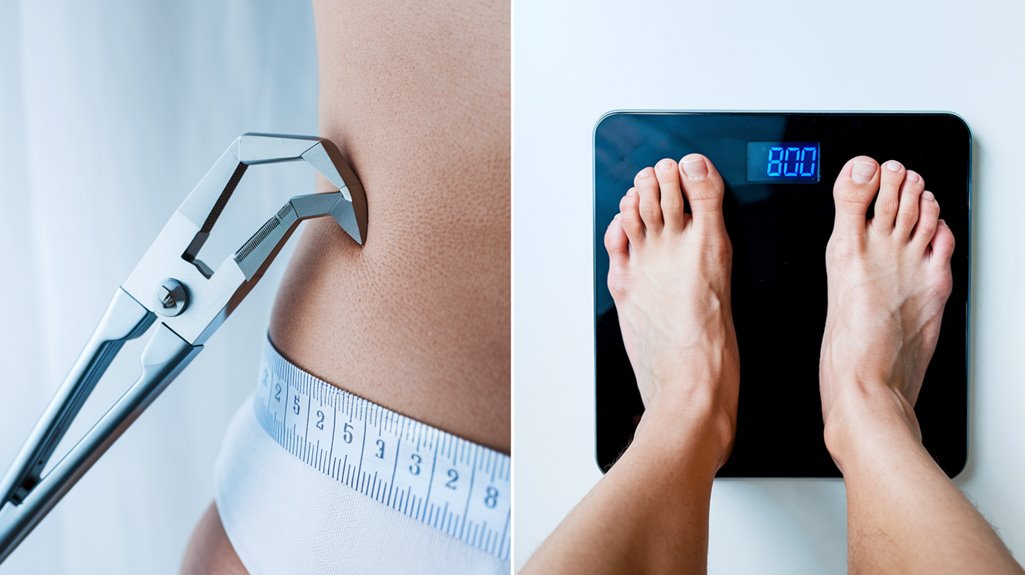
When tracking belly fat, you'll find that skin-fold calipers offer superior accuracy compared to smart scales, especially for targeted measurements. While smart scales provide convenient multi-metric tracking through BIA technology, they can deviate 3-8% from gold-standard measurements and are affected by hydration levels. Calipers, though requiring proper technique, deliver more precise readings at a lower cost. Understanding the key differences between these methods will help you make the most informed choice for your fitness journey.
Body fat measurement serves as a crucial indicator of overall health and fitness progress. You'll find several methods available, each with distinct advantages and limitations. The main approaches include skinfold calipers, bioelectrical impedance analysis (BIA), dual-energy X-ray absorptiometry (DXA), hydrostatic weighing, and air displacement plethysmography.
Your choice of measurement method should align with your specific needs. If you're seeking convenience, BIA devices like smart scales offer quick results but can be affected by hydration levels. For detailed fat distribution analysis, skinfold calipers provide targeted insights, though they require skilled operation. When precision is paramount, DXA scans deliver thorough data but at a higher cost.
Remember that each method's accuracy depends on various factors. BIA results fluctuate with hydration status, while caliper measurements rely heavily on technician expertise. For the most reliable assessment, you might consider combining multiple methods under professional guidance. While methods like hydrostatic weighing are considered the gold standard, they require specialized equipment and facilities.
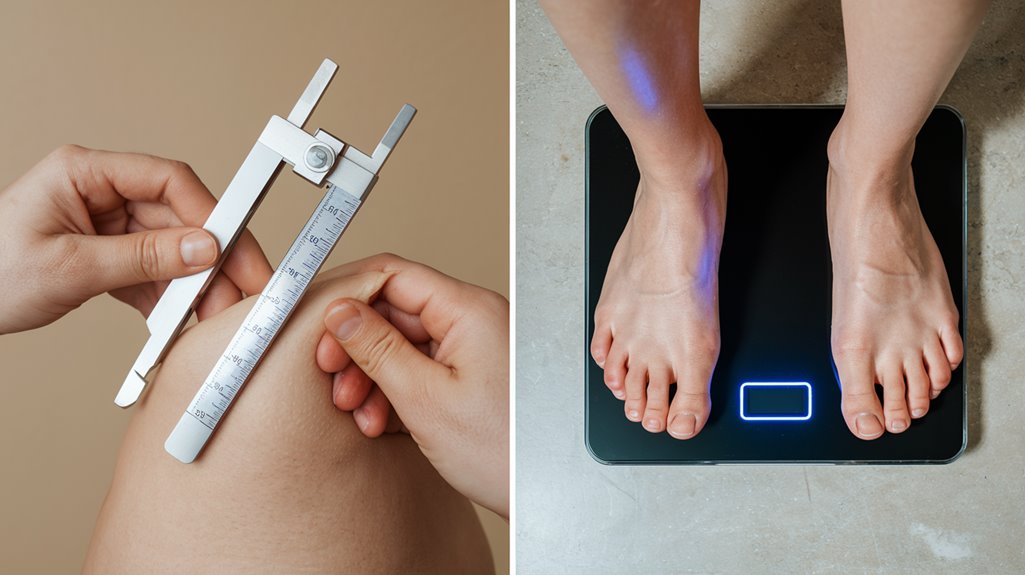
When you step on a smart scale, it uses bioelectrical impedance analysis (BIA) to measure your body composition by sending a painless electrical current through your body via electrodes under your feet. Your body's tissues respond differently to this current – fat resists the flow while muscle and water conduct it more readily, allowing the scale to calculate various body composition metrics. Modern smart scales employ multi-frequency signal processing to improve measurement accuracy across different tissue types, though they're still affected by factors like hydration levels and body temperature. The best smart scales can sync data with over 100 fitness apps to provide comprehensive health tracking and monitoring capabilities.
Modern smart scales rely on a sophisticated technology called Bioelectrical Impedance Analysis (BIA) to measure body composition. When you step on a BIA scale, it sends a low-level electrical current through your body. Since fat tissue contains less water than muscle, it provides more resistance to this current, allowing the scale to estimate your body fat percentage.
Your scale combines this resistance measurement with your personal data, including age, gender, and height, to calculate various body composition metrics. While BIA technology isn't as precise as methods like DEXA scans, it's convenient for tracking trends over time. Keep in mind that hydration levels notably affect readings, so you'll get the most reliable results by weighing yourself under consistent conditions. Most smart scales can sync this data with health apps, making it easier to monitor your progress. For optimal accuracy and functionality, the scale should be placed on a flat, hard surface and kept away from carpeted areas.
Smart scale technology has evolved beyond simple BIA to incorporate multi-frequency signal processing, a sophisticated advancement that enhances measurement accuracy. Similar to radar systems analyzing LSS targets, smart scales use multiple frequencies to assess different aspects of body composition. You'll find that modern scales use multiple frequencies simultaneously to analyze different tissue types in your body, providing a thorough assessment of your body composition.
| Frequency Range | Tissue Measured | Key Benefit |
|---|---|---|
| Low (1-5 kHz) | External Fluid | Water Balance |
| Mid (50 kHz) | Total Body Water | Hydration Status |
| High (100+ kHz) | Internal Fluid | Muscle Mass |
| Multiple | All Tissues | Complete Analysis |
The real-time processing of these frequencies through advanced algorithms allows your smart scale to deliver instant results. While you'll get more detailed data than traditional methods, remember that factors like hydration and meal timing can affect readings.
Mastering caliper technique is essential for accurate body fat measurements. You'll need to follow standardized protocols that typically involve measuring 3 to 7 specific sites, including the triceps, abdomen, and thighs. For each site, take multiple readings at least 15 seconds apart and average the results.
When using calipers, clean them before and after use, and maintain proper hand hygiene. Position your thumb and index finger to pinch the skinfold one centimeter above the measurement site, then place the caliper perpendicular to the fold. Release the trigger and read the dial after two seconds. Create a three-inch space between your fingers when pinching the skin fold.
For consistent results, always measure the right side of your body. The 3-site method focuses on chest, abdomen, and thigh measurements, while the 7-site method adds triceps, suprailiac, subscapular, and midaxillary points. For abdominal measurements, place the caliper about an inch right of the navel.
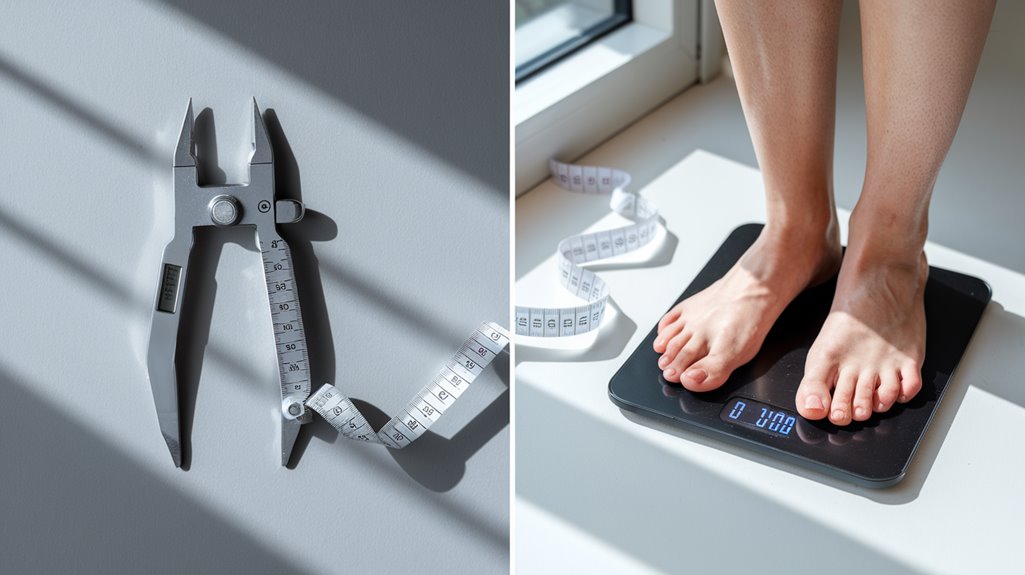
While proper caliper technique sets the foundation for accurate measurements, real-world comparisons between calipers and smart scales reveal significant differences in reliability. You'll find that calipers, when used by trained professionals, deliver superior accuracy in measuring subcutaneous fat compared to smart scales, which can be off by up to 34% from lab-based measurements.
Smart scales using bioelectrical impedance often produce inconsistent results due to variations in hydration levels and proprietary algorithms. While they're convenient for tracking general trends, you shouldn't rely on them for precise measurements. They're particularly sensitive to recent meals and physiological changes. Smart scales ranging from AED 1,200 and above offer multiple body composition metrics through their advanced technology.
For the most thorough body composition assessment, you might want to combine both methods. Calipers excel at measuring specific sites and subcutaneous fat, while smart scales can track overall trends and provide additional metrics like muscle mass and water content. Just remember that consistency in measurement timing and conditions is essential for both methods.
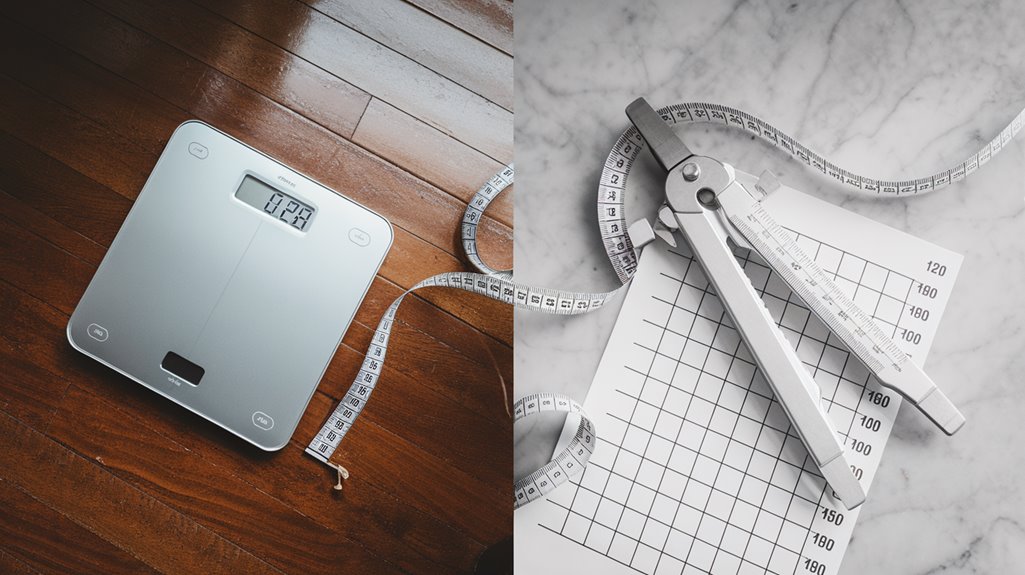
Investing in body fat measurement tools requires careful consideration of both immediate costs and long-term value. While calipers offer an affordable entry point at AED 50-300, smart scales range from $20 to upwards of AED 1,200 for professional models.
You'll find calipers provide excellent cost efficiency, requiring minimal maintenance and offering high accuracy when used properly. They're portable and deliver direct subcutaneous fat measurements without additional equipment costs. However, you'll need to invest time in learning proper technique.
Smart scales justify their higher price tag through extensive data collection and convenience. You're getting multiple metrics, including body fat percentage, muscle mass, and water content, all instantly displayed and tracked through connected apps. While they're more expensive upfront, they're time-efficient and user-friendly, making them ideal for daily monitoring. Your choice should ultimately depend on whether you prioritize detailed, manual measurements or convenient, automated tracking with broader health insights. Since smart scales use bioelectrical impedance analysis, results can be affected by your hydration levels and recent food consumption.

Selecting the right belly fat tracking tool depends heavily on your specific fitness goals and how you'll use the measurements. If you're an athlete or fitness professional requiring precise measurements and detailed data about fat distribution, calipers will serve you better despite the learning curve. For those focused on general fitness and consistent tracking at home, a smart scale's convenience and multiple measurement features might align better with your needs, even though it won't match a caliper's accuracy. Consider that readings on digital scales can fluctuate by up to 3% throughout the day due to various physical conditions.
Making an informed choice between a caliper and smart scale depends primarily on your specific fitness goals and measurement needs. If you're focused on tracking subcutaneous fat distribution for targeted weight loss, you'll find calipers more suitable due to their precision and specificity. They're also budget-friendly, ranging from AED 50 to AED 300.
If you want extensive body composition data, including muscle mass and water content, a smart scale is your better option. While pricier, with high-end models like the InBody series costing over AED 1,200, they provide broader insights for long-term tracking. For optimal results, maintain consistent hydration levels when using smart scales, as water content significantly affects readings. Consider your comfort level too – while scales are straightforward to use, calipers require proper technique and some users find the pinching uncomfortable. For professional use, calipers remain the preferred choice due to their superior accuracy in measuring subcutaneous fat.
When weighing accuracy against convenience, the choice between calipers and smart scales presents distinct tradeoffs for belly fat tracking. While calipers offer superior accuracy with direct subcutaneous fat measurements, they'll require training and time investment to master proper technique. Smart scales using BIA technology provide instant results and app integration but can deviate 3-8% from gold-standard measurements.
You'll find that smart scales excel in convenience, offering quick daily measurements and automated tracking. However, they won't provide specific data about fat distribution patterns. Calipers, though more time-consuming, deliver precise measurements at exact anatomical points. For the most accurate body composition analysis, consider getting a DEXA scan, as demonstrated by recent testing showing significant differences from consumer device readings. If you're prioritizing accuracy for professional or athletic purposes, choose calipers. If you're seeking easy, consistent tracking for general fitness goals, a smart scale might better suit your needs.
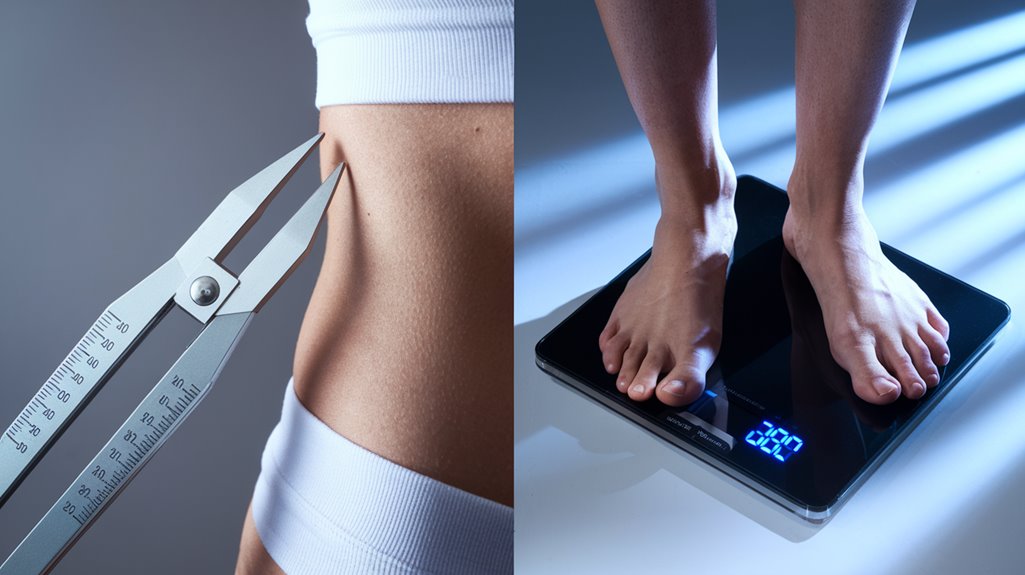
To achieve ideal accuracy in tracking belly fat, understanding the proper techniques for both calipers and smart scales is essential. By combining both methods, you'll get a more thorough view of your body composition while minimizing the limitations of each tool. When using calipers, verify you're trained in proper technique and measure consistently at 3-7 specific sites. For smart scales, track your measurements at the same time each day to account for hydration and food intake variations.
Remember that smart scales may deviate 3-8% from DEXA scans, while caliper accuracy depends heavily on user experience. By understanding these limitations, you can select the most appropriate method for your specific tracking needs.
Just as a skilled carpenter wouldn't rely on a single tool to build a masterpiece, you'll get the most accurate picture of your body composition by combining both measurement methods. While smart scales offer convenience and extensive data tracking, calipers provide direct subcutaneous measurements. You're best served using calipers for specific spot-checking and smart scales for tracking overall trends in your body fat journey.